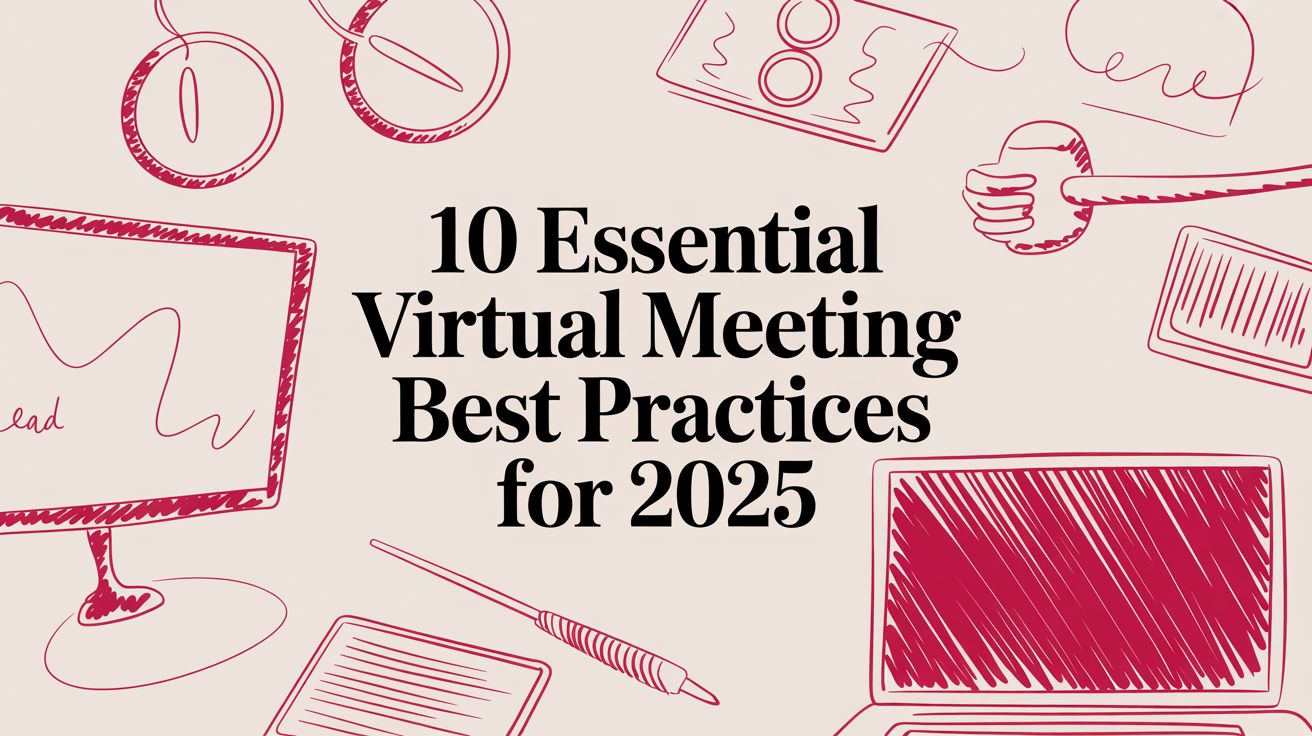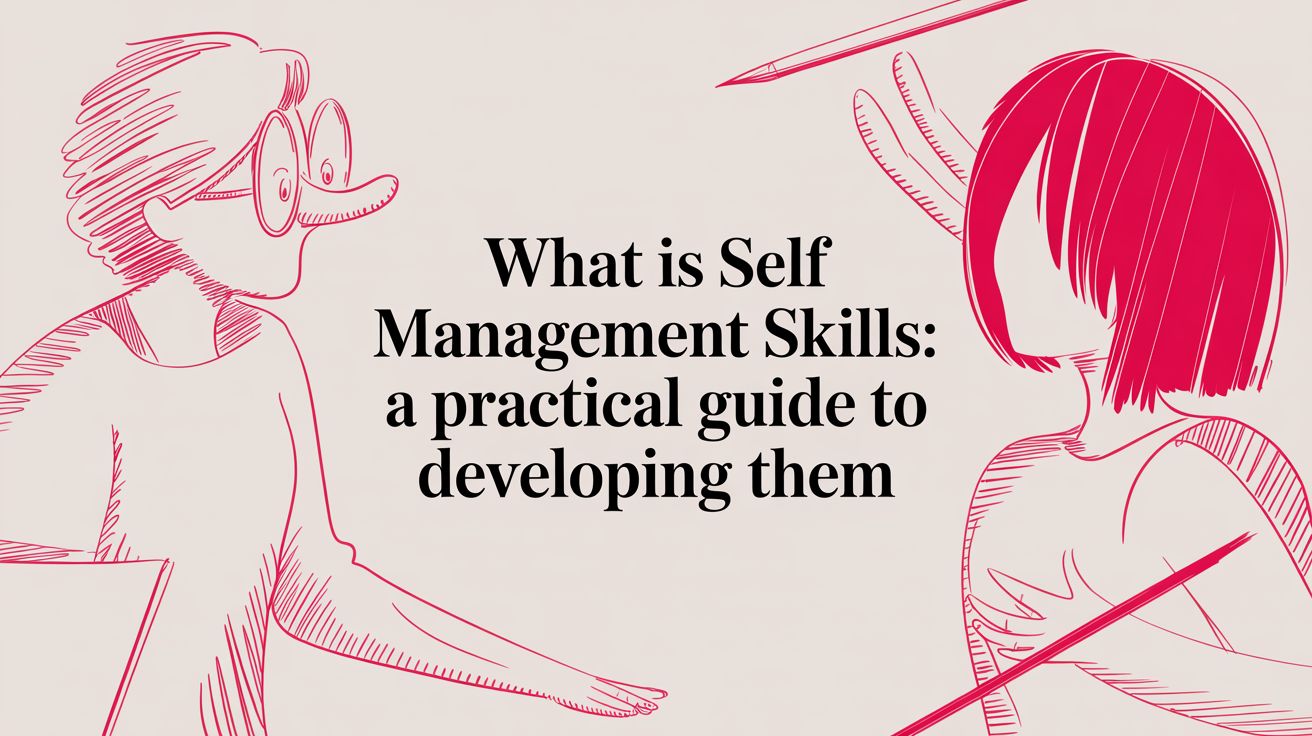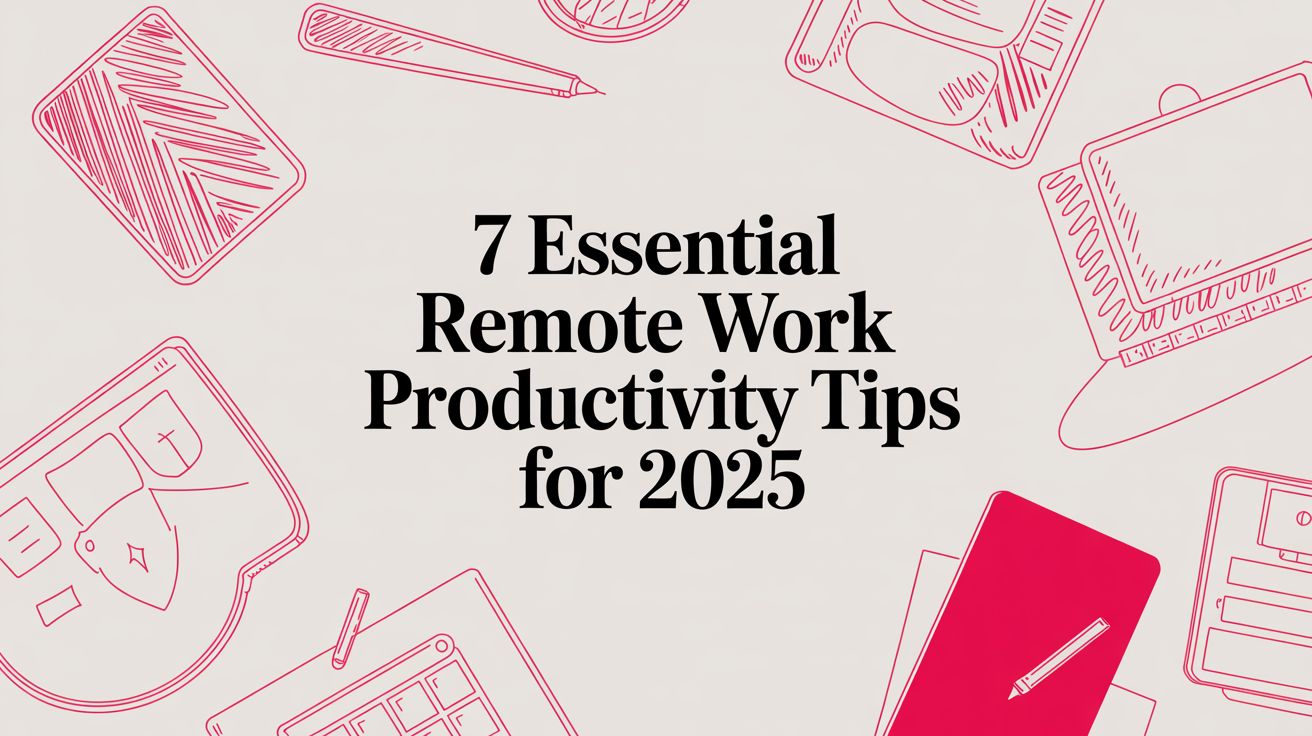Remote Design Jobs Entry Level: Start Your Career Today
Max
Landing remote design jobs for entry level candidates isn’t just about having a great portfolio—it’s about playing the game smart. You need a targeted strategy, because while the opportunities are out there, the competition is intense. The secret is knowing where to look and how to go beyond the massive, overcrowded job boards.
Understanding the Remote Design Job Market
Breaking into the design field is a challenge on its own. Trying to land a remote role right out of the gate? That adds a whole new layer of complexity.
The dream of working from anywhere is a powerful one, and you’re definitely not the only one chasing it. This means even a single junior position can get absolutely flooded with hundreds of applicants. It’s easy to get discouraged, but don’t.
The Reality of Competition
Let’s be real about the numbers. The demand for remote work is way higher than the supply, which creates a serious bottleneck.
To give you some perspective on the current job market, we’ve put together a quick overview of the key stats you should know. This isn’t meant to scare you off, but to help you understand just how important a targeted strategy is.
Entry Level Remote Design Job Market at a Glance
| Metric | Key Statistic |
|---|---|
| Fully Remote Postings | Only 6% of new job listings in early 2025 are fully remote. |
| Total Remote/Hybrid Listings | Remote and hybrid roles make up just 20% of all available jobs. |
| Application Volume | A massive 60% of all job applications are for remote or hybrid positions. |
These numbers paint a clear picture: a huge number of people are competing for a relatively small number of remote roles. This imbalance means your application has to be exceptional just to get a first look. You can explore these remote and hybrid work statistics further to get a full sense of the competitive landscape.
The challenge isn’t a lack of talent—it’s an abundance of it, all vying for the same coveted remote roles. Your goal isn’t just to be qualified; it’s to prove you’re undeniably the best fit for a remote-first culture.
Where to Focus Your Search
Instead of letting the competition get you down, use it to your advantage. A scattergun approach of applying everywhere just doesn’t work. You need to be way more strategic.
Your best bet is to focus on companies that are not just “remote-friendly” but truly “remote-first.” These are the organizations that have built their entire culture around asynchronous communication, trust, and distributed teams. They get it.
Here’s where you’ll often find them:
- Tech Startups: Many are agile and were built on remote collaboration from the very beginning. They live and breathe it.
- Established SaaS Companies: Their products often enable remote work, so it’s no surprise their company culture does, too.
- Digital and Creative Agencies: A lot of agencies have shifted to a distributed model to attract the best designers, no matter where they live.
Understanding these industry dynamics and the latest remote work trends is your secret weapon. It allows you to tailor your portfolio and your applications to speak directly to the companies that are actively looking for—and know how to support—entry-level remote designers.
Building a Portfolio That Screams Remote Ready
Let’s get one thing straight: your portfolio is the single most important piece of the puzzle when you’re hunting for remote design jobs for entry level roles. It’s so much more than a gallery of pretty pictures. Think of it as your number one sales tool.
A hiring manager for a remote position is looking for more than just a good eye for design. They’re digging for proof that you can actually thrive without someone looking over your shoulder. Your portfolio needs to shout from the rooftops that you’re self-sufficient, a great communicator, and organized enough to deliver incredible work without constant in-person hand-holding.
Showcase Your Process, Not Just the Polished Product
So many junior designers make the classic mistake of only showing off the final, pixel-perfect designs. Big mistake, especially for remote roles. When you’re not in the office, the “how” you got there is just as critical as the “what” you produced. Hiring managers need to see inside your brain and understand how you tackle problems on your own.
The best way to do this? Structure your projects as detailed case studies. Don’t just slap up the final mockup. Take them on the entire journey.
- The Problem: Start by clearly explaining the problem you were trying to solve. What was the user’s pain point? What was the business goal?
- Your Role: Be explicit about what you did, especially if it was a group project. Did you lead the research? Were you responsible for the final UI? Spell it out.
- Discovery & Research: Show your work! Include sketches, user personas, or a competitive analysis. This proves you don’t just jump straight to designing.
- Ideation & Iteration: This is where the magic happens. Display your wireframes, user flows, and prototypes—yes, even the messy early versions. Explain why you made certain decisions and how feedback shaped the outcome.
Laying out your process like this proves you can think strategically and document your work—two skills that are non-negotiable for asynchronous collaboration. For a deeper dive, our guide to building a good UX portfolio has even more ideas.
Weave in Your Remote Collaboration Skills
Your case studies are the perfect stage to show off the skills that make you a great remote teammate. Instead of just listing tools like “Figma” and “Slack” on your resume, show recruiters how you actually used them.
A remote-ready portfolio doesn’t just show what you can do; it shows how you do it within a distributed team environment. It’s about proving your reliability and communication skills through tangible project examples.
For instance, you could explain how you used Figma’s commenting features to get feedback from a mentor while working on different schedules. Maybe you used Miro for a virtual brainstorming session. Did you use Asana or Slack to keep the project on track?
Mentioning these tools in the context of a real project is powerful. It gives hiring managers concrete evidence that you can slide right into their existing remote workflow. When you’re ready to put it all online, choosing the best website builder for your resume portfolio will help you present these detailed case studies effectively.
Pick Projects That Signal Independence
The type of projects you feature sends a huge message. Group projects from school are fine, but if you really want to stand out, self-initiated projects are absolute gold. They scream “I’m a self-starter!”
Think about including a personal project, a redesign concept for an app you love (or hate), or even a small freelance gig. These kinds of projects demonstrate:
- Proactivity: You don’t just wait around to be told what to do. You spot problems and create your own solutions.
- Self-Management: You can take a project from concept to completion, setting your own deadlines and milestones along the way.
- Passion: It proves you genuinely love design and are driven to create, even when it’s not for a grade.
By carefully selecting your projects and framing them as compelling, remote-ready case studies, your portfolio will do more than just show off your skills. It will tell a story about why you’re the perfect fit for a modern, distributed design team.
Finding Opportunities Beyond the Usual Job Boards
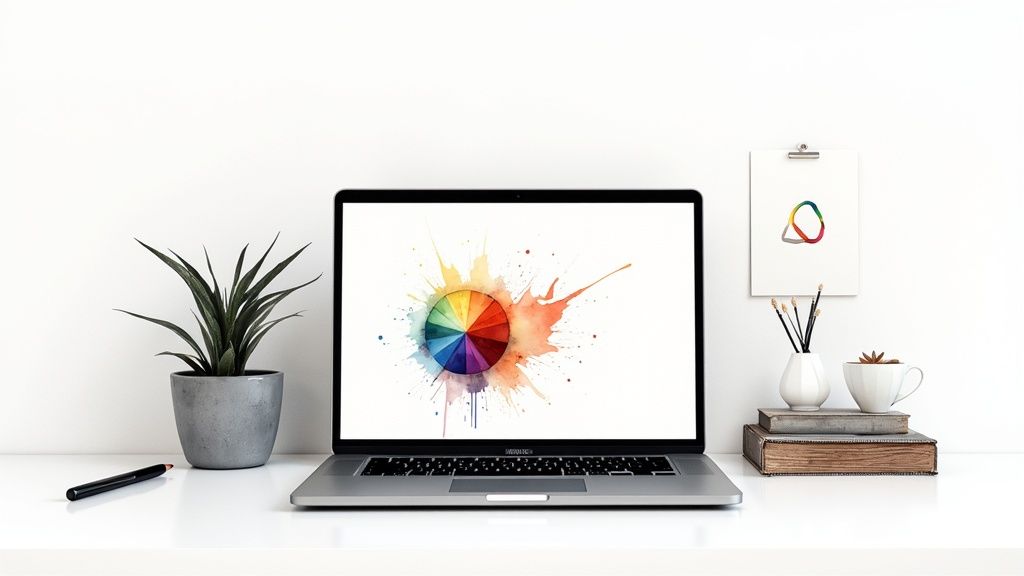
If your job search consists of firing off applications on Indeed or LinkedIn, you’re likely feeling like you’re shouting into the void. When you’re looking for remote design jobs for entry level candidates on these massive platforms, your application is just one in a digital pile of thousands.
To actually get noticed, you need to start looking where everyone else isn’t. This is about being strategic—moving past the generic job boards and into niche platforms and communities where your portfolio has a real chance to shine.
The good news is that the global shift to remote work has created more of these specialized corners of the internet. By 2023, roughly 28% of employees worldwide were working fully remote, a massive leap from just a few years ago. This trend is a huge advantage for junior designers who can prove their skills digitally.
Tap Into Niche and Remote-First Platforms
Instead of playing a numbers game on giant job boards, focus your energy on platforms where quality beats quantity. These sites are magnets for companies with a genuine remote-first culture, which means they’re actually set up to support and mentor junior talent from a distance.
Here’s where to start looking:
- Remote-Only Job Boards: Think of these as curated lists of opportunities from companies that are already fully distributed. No more filtering for “remote” only to find it’s a hybrid role in another state.
- Design-Specific Communities: Slack groups and online forums for designers often have exclusive job channels. This is where you find roles that never even make it to the big public boards.
- Startup-Focused Sites: Early-stage companies are often remote by default and are far more willing to hire based on a strong portfolio and raw potential rather than years of formal experience.
We’ve actually put together a comprehensive list to get you started. Check out our guide on the best remote job websites to find the platforms that fit what you’re looking for.
Master Your Professional Networking Presence
Job boards are only one piece of the puzzle. Professional networking platforms are where the hidden opportunities live. Your profile needs to do more than just exist; it needs to attract recruiters.
It sounds small, but even details like optimizing your LinkedIn profile picture can make a surprising difference in how you’re perceived professionally.
Your job search shouldn’t be passive. Actively engaging in design communities, following companies you admire, and connecting with people in roles you aspire to can open doors that a simple application never could.
Create Smart Job Alerts and Vet Companies
Once you’ve found the right platforms, it’s time to get smart with your alerts. Don’t just set an alert for “graphic designer” and call it a day. Use specific, long-tail keywords to uncover the real gems.
Try setting up alerts for phrases like these:
- “Junior Product Designer remote”
- “Entry Level UI/UX async”
- “Associate Visual Designer distributed team”
When you find a role that looks promising, your work isn’t over. You need to vet the company for a true remote-first culture. Ask them directly in the interview about how they onboard remote employees, what their communication practices look like, and if they offer mentorship for junior staff.
A company that genuinely values remote work will have clear, enthusiastic answers. This approach helps you find more than just a job—it helps you find the right environment to kickstart your career.
Crafting Applications That Get Noticed

When you’re up against hundreds of other designers for the same remote design jobs for entry level roles, a generic application is a one-way ticket to the “no” pile. Think of your resume and cover letter as your opening pitch. They have to be sharp, specific, and impossible to ignore.
Recruiters spend just a few seconds scanning your resume. In that tiny window, they’re hunting for keywords that prove you’re a good fit not just for design, but for a remote team. This is your chance to frame every single piece of experience—even that personal project you did last summer—through a professional, remote-ready lens.
Tailoring Your Resume for Remote Readiness
Your resume needs to do more than just list your design skills. It has to scream that you can work autonomously and collaborate effectively from anywhere. Instead of simply saying you’re “Proficient in Figma,” talk about how you used it for asynchronous collaboration on a team project.
Put yourself in the hiring manager’s shoes. They’re wondering: Can this person manage their own time? Can they communicate clearly without being in the same room? Your resume needs to answer those questions.
- Highlight Your Tools: Don’t just list them. Mention specific platforms like Slack, Asana, Miro, or Trello and connect them to an action. For example, “Managed project timelines and deliverables using Asana” or “Facilitated remote brainstorming sessions in Miro.”
- Showcase Self-Management: Use action verbs that ooze independence. Words like “Initiated,” “Managed,” “Led,” and “Organized” are gold. They tell a recruiter you don’t need someone looking over your shoulder.
- Quantify Everything: Numbers grab attention. Instead of “Designed social media graphics,” try “Designed 20+ social media graphics that boosted engagement by 15%.” This turns a vague statement into a concrete achievement.
For a much deeper dive, we have a whole guide on building a killer resume for remote jobs. It’s packed with more examples to make your remote-work potential undeniable.
Writing a Cover Letter That Tells a Story
Your cover letter is where you connect the dots. It’s your chance to weave a narrative that links your portfolio, your resume, and what the company actually needs. It’s also where you show you understand why remote work matters. After all, a recent study showed that 91% of employees want to work remotely at least some of the time, which is fueling the demand for creative roles that fit that lifestyle.
Your cover letter shouldn’t just repeat your resume. It should tell a concise story about your passion for design, your understanding of the company’s mission, and why you are uniquely prepared to succeed in a remote role from day one.
Skip the generic “To Whom It May Concern.” Start with a hook that proves you’ve done your homework. Mention a specific project of theirs you admire, or connect one of your skills to a value you saw on their careers page. That little bit of effort shows you’re genuinely interested and immediately sets you apart from the crowd.
Nailing Your Remote Interview and Design Challenge
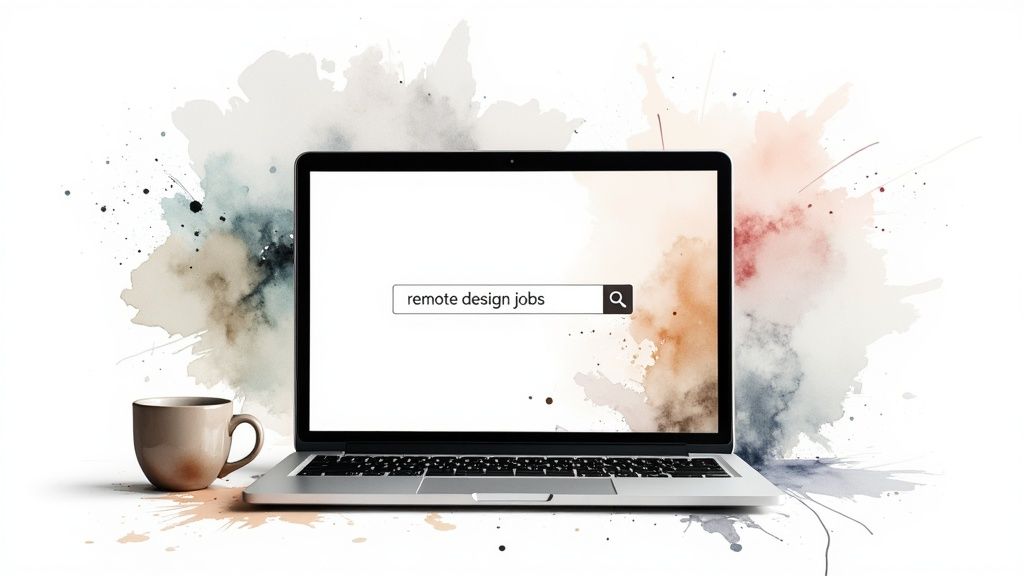 You landed the interview for an entry-level remote design job—fantastic! Now it’s time to show them you’re as sharp on screen as you are on paper. A remote interview is a unique kind of performance where your communication, your tech setup, and your design thinking are all on display.
You landed the interview for an entry-level remote design job—fantastic! Now it’s time to show them you’re as sharp on screen as you are on paper. A remote interview is a unique kind of performance where your communication, your tech setup, and your design thinking are all on display.
This is about more than just answering questions. It’s your chance to build a real connection through a screen and prove you have what it takes to contribute from anywhere. Hiring managers aren’t just looking at your design skills; they’re trying to picture you as a future remote colleague.
Setting the Stage for a Flawless Virtual Interview
First impressions count, especially over video. A glitchy connection or a messy background can send the wrong message before you even say a word. You don’t need a professional studio, but getting a few basics right shows you’re serious.
- Test Your Tech: Do a quick trial run with a friend. Check your camera, mic, and internet. Make sure your face is well-lit from the front—not backlit by a bright window.
- Curate Your Background: A clean, uncluttered background is a must. A simple, neutral wall, a tidy bookshelf, or even a tasteful virtual background works great.
- Communicate with Confidence: Look directly into the camera to create a sense of eye contact. Speak clearly, and don’t be afraid to use hand gestures to bring some energy to the conversation. For more tips, check out our guide on acing your remote interview.
Decoding the Take-Home Design Challenge
The take-home challenge is a classic part of the hiring process for remote design jobs for entry level candidates. It’s your opportunity to show them how you think, not just what you can make. It’s easy to get lost in polishing the final visuals, but that’s not what they’re truly looking for.
Hiring managers want to see your process. They need to understand the why behind every single design decision you made. Make sure you document everything, from your first sketches to your final mockups.
Your presentation of the design challenge is just as important as the design itself. A beautiful solution with a confusing or poorly explained rationale will fall flat. Clearly articulate your thought process and tie every decision back to the original problem.
This approach shows you can work independently and communicate your ideas asynchronously—two non-negotiable skills for a remote designer. It’s why companies love this model. They’ve seen cost savings between 30% and 70% by going remote, so they’re eager to find talent that’s built for it. You can see more stats on the financial upsides of remote work on easystaff.io.
Presenting Your Solution with Impact
When it’s time to present your work, think of it as telling a story. Don’t just click through your Figma screens. Guide them through your entire journey, from start to finish.
- Restate the Problem: Kick things off by showing you fully grasped the brief and the user problem you were asked to solve.
- Show Your Work: Briefly touch on your research, user flows, and early wireframes. Explain the key decisions that shaped your direction.
- Reveal the Solution: Now, present your final designs. Connect specific UI choices and features directly back to the user’s needs.
- Discuss Next Steps: Show you’re a forward-thinker. Suggest what you would do next if you had more time, like specific user tests or future iterations.
Framing your presentation as a narrative showcases your strategic thinking and solidifies your spot as a top-tier candidate.
Common Questions About Starting a Remote Design Career

As you start looking for remote design jobs for entry level candidates, it’s totally normal to have some questions floating around. Let’s clear up a few of the most common ones so you can move forward with confidence.
What Is a Realistic Entry Level Salary?
Money talk can be tricky. Remote design salaries swing wildly based on things like where the company is, its size, and what exactly you’ll be doing day-to-day. But you can definitely expect a competitive starting point.
For a junior remote designer in the U.S., you’re typically looking at a range between $50,000 and $75,000 a year. A scrappy startup might be on the lower end of that but sweeten the deal with equity, while big tech companies usually offer more. Don’t forget to weigh any offer against the cost of living where you are.
Essential Tools for a Home Setup
Good news: you don’t need a fancy, high-tech studio to get the job done. But a few key pieces of gear are non-negotiable if you want to be productive and professional from day one. Think of this as your remote designer starter pack.
- A Solid Computer: Your machine has to run design software without sputtering. Whether you’re on a Mac or PC doesn’t really matter—both are common in the industry.
- High-Speed Internet: Glitchy video calls and slow file uploads are a remote worker’s nightmare. A stable connection is an absolute must.
- Decent Webcam and Mic: You don’t need podcast-level quality, but clear audio and video are crucial for coming across professionally.
- The Right Software: Most companies will give you software licenses. The expectation, though, is that you already know your way around tools like Figma, Sketch, and the Adobe Creative Suite.
Your ability to communicate effectively is your most important tool. A simple, reliable tech setup ensures that your ideas—not technical glitches—are the focus of every meeting and collaboration session.
Showcasing Soft Skills Without Experience
How do you prove you’re a great communicator or a time-management wizard when you don’t have a long resume? The secret is to show, not just tell. Your portfolio and interview are the perfect places to do this.
When you’re walking someone through a personal project, don’t just show them the slick final design. Talk them through your process. Explain how you set your own deadlines to get it finished. Describe how you got feedback from a mentor or a friend—that’s a perfect example of your collaboration skills in action.
Every project, even a passion project, tells a story about your work ethic. Frame it that way, and you’ll give them the proof they need that you’re ready for the freedom and responsibility of a remote role.
Ready to find the perfect role to launch your career? Remote First Jobs offers thousands of curated listings from companies that truly understand and support remote work. Start your search and discover your next opportunity today.
